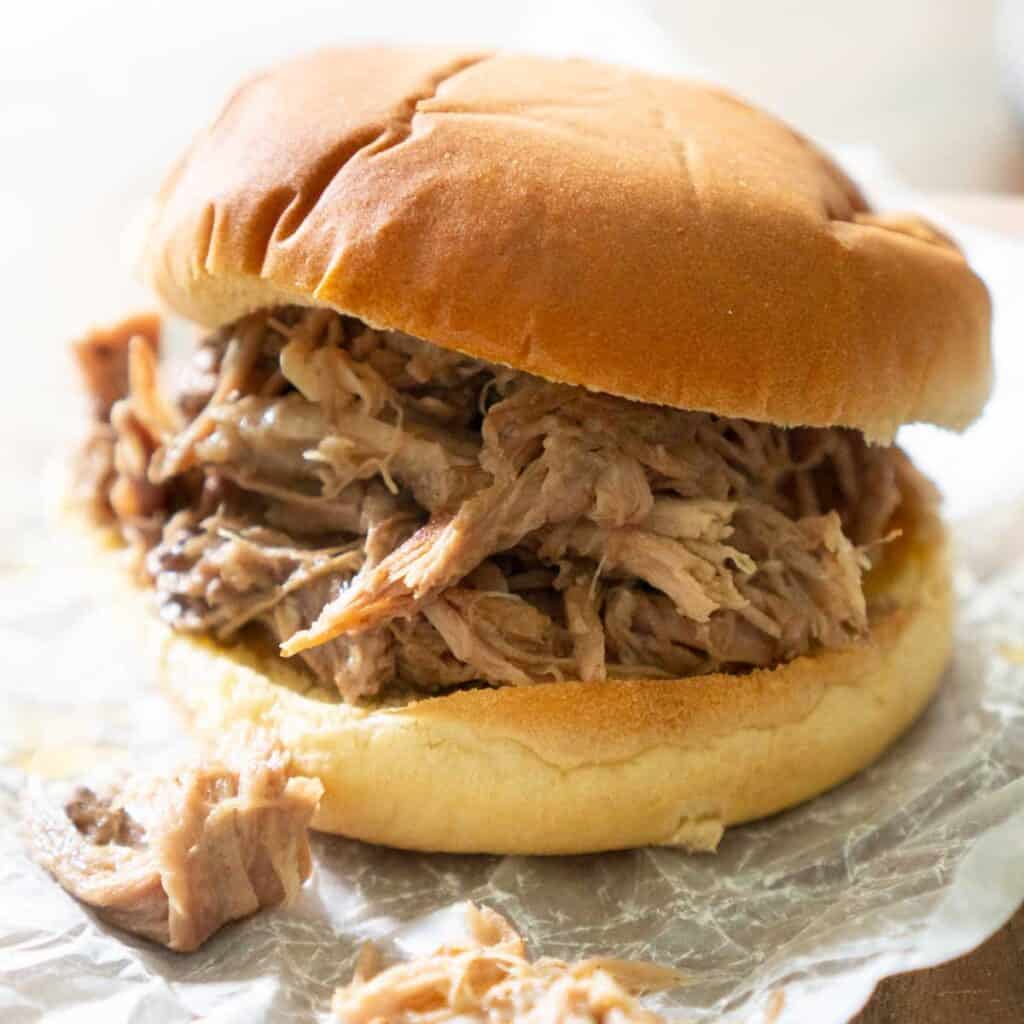Leftover pulled pork has the potential to transform into mouthwatering meals, but only if reheated properly.
Don’t let that tender, flavorful meat go to waste!
In this article, we’ll uncover the secrets of reheating pulled pork, revealing the most effective methods and handy tips to revive its deliciousness.
Get ready for a porky adventure that will leave you craving more!
how to reheat pulled pork
To reheat pulled pork, there are several methods you can use.
The best options include using the oven, stovetop, air fryer, smoker, grill, or crockpot.
It is important to properly store and refrigerate leftover pork to avoid foodborne illnesses.
When reheating in the oven, set the temperature to around 325 degrees F and add moisture with sauce or broth.
On the stovetop, use a saucepan with low heat and add water or broth.
It is crucial to heat the pork to an internal temperature of 165°F before consuming.
Remember that reheating pulled pork multiple times can cause it to dry out and increase the risk of bacterial growth.
Additionally, leftover pulled pork can be used in various dishes such as baked potatoes, enchiladas, or stir-fries.
Experiment with different methods and recipes, and share your experiences on social media platforms like Pinterest and Instagram.
Key Points:
- Reheating pulled pork can be done using the oven, stovetop, air fryer, smoker, grill, or crockpot.
- Leftover pork should be properly stored and refrigerated to avoid foodborne illnesses.
- When reheating in the oven, set the temperature to 325 degrees F and add moisture with sauce or broth.
- On the stovetop, use low heat in a saucepan and add water or broth.
- Heat the pork to an internal temperature of 165°F before consuming.
- Reheating pulled pork multiple times can cause it to dry out and increase the risk of bacterial growth.
how to reheat pulled pork – Watch Video
💡
Pro Tips:
1. Pulled pork was originally popularized in the United States by Southern barbecue enthusiasts who found creative ways to use leftover bits of pork, including simmering and pulling the meat into thin shreds.
2. To reheat pulled pork, try placing it in a slow cooker or a heavy-bottomed pot over low heat with a splash of liquid (such as apple cider vinegar or barbecue sauce) for added moisture and flavor.
3. Pulled pork has roots dating back to medieval times when pork was slow-cooked and shredded for easy preservation and consumption during long winters.
4. If you’re short on time and need to reheat pulled pork quickly, wrap the meat in aluminum foil, place it in a preheated oven at 350°F (175°C), and heat for 10-15 minutes until warmed through.
5. Pulled pork is known by different names around the world, such as “pulled shoulder” in the United Kingdom, “pulled pork sandwich” in the United States, and “carne desmechada” in Latin America.
1. Reheating Pulled Pork: Avoiding Food Waste And Saving Money
In the United States, an alarming 40% of all food goes to waste each year, equivalent to a staggering 108 billion pounds. This high level of food waste not only has environmental implications but also impacts our wallets.
One effective approach to combating food waste and saving money is to find creative and delicious ways to use leftovers. Reheating pulled pork is just one example of how leftovers can be repurposed into tasty and versatile ingredients.
When it comes to reheating pulled pork, proper technique is crucial in order to prevent wastage and preserve the deliciousness of this succulent meat. In this article, we will explore different methods for reheating pulled pork and provide helpful tips to ensure it remains juicy and tender.
To reheat pulled pork effectively, consider the following tips:
- Avoid overheating: Double-check the temperature settings on your reheating equipment to ensure you do not overcook the pork, which can lead to dryness.
- Use a gentle heat: Opt for a lower heat setting to slowly warm up the pulled pork, allowing it to retain its moisture and tenderness.
- Add moisture: If the pulled pork appears dry during reheating, consider adding a small amount of broth, sauce, or water to restore moisture.
- Cover the dish: When reheating pulled pork in an oven or microwave, cover the dish with aluminum foil to trap in heat and prevent excessive drying.
- Stir occasionally: If you are reheating pulled pork on the stovetop or in a slow cooker, remember to stir it occasionally to ensure even heating.
- Consider adding seasoning: To enhance the flavor of the reheated pulled pork, consider adding a touch of barbecue sauce, spices, or herbs while it warms up.
By following these tips and experimenting with different reheating methods, you can enjoy the deliciousness of leftover pulled pork while minimizing food waste.
- Bullet point outcomes:
- Overheating should be avoided to prevent dryness.
- A lower heat setting is recommended for gentle reheating.
- Adding moisture, such as broth or sauce, can restore juiciness.
- Covering the dish with foil helps trap heat and avoid excessive drying.
- Stirring occasionally during reheating ensures even heating.
- Consider adding seasoning, such as barbecue sauce or spices, for enhanced flavor.
2. The Best Methods For Reheating Pulled Pork: Oven, Stovetop, Air Fryer, Smoker, Grill, Or Crockpot
When it comes to reheating pulled pork, there are several options available:
-
Oven: Set the temperature to around 325 degrees Fahrenheit and add moisture with sauce or broth. This method ensures even heating and prevents the pork from drying out.
-
Stovetop: Place the meat in a saucepan over low heat and add water or broth for moisture. This option is quick and convenient, suitable for small portions.
-
Air fryer: If you have an air fryer, it can be an excellent choice for reheating pulled pork. The hot air circulates and crisps up the meat, giving it a delicious texture.
-
Smoker or grill: Using a smoker or grill can add a smoky and charred flavor to the reheated pulled pork, taking its taste to a whole new level.
-
Crockpot: For those who prefer a slow and hands-off approach, using a crockpot can yield tender and juicy results.
Remember, regardless of which method you choose, proper reheating techniques will ensure the best outcome for your pulled pork.
(Create bullet points for each option. Add a blockquote at the end)
3. Proper Storage And Refrigeration Of Leftover Pulled Pork: Ensuring Food Safety
Before reheating leftover pulled pork, it is important to store and refrigerate it properly. This retains its quality and ensures food safety. When storing pulled pork in the refrigerator, make sure to seal it tightly and place it in the coldest part of the fridge. This prevents bacterial growth and keeps the meat fresh.
Properly sealed pulled pork can stay good in the refrigerator for 3 to 4 days. If you are not planning to consume it within this timeframe, you can extend its shelf life by freezing it. When freezing pulled pork, use an airtight container or a vacuum-sealed bag to maintain its texture and prevent freezer burn. Pulled pork can last up to 3 months in the freezer, allowing you to enjoy it at a later date.
4. Reheating Pulled Pork In The Oven: Tips For Moist And Delicious Results
Reheating pulled pork in the oven can result in moist and delicious meat. Here’s how:
- Preheat the oven to around 325 degrees Fahrenheit.
- Place the pulled pork in an oven-safe dish or baking tray.
- Add moisture by pouring sauce or broth over the meat.
- Cover the dish tightly with foil to retain moisture and prevent it from drying out.
It’s essential to reheat pulled pork slowly in the oven to ensure even heating. This way, the meat will retain its tenderness and won’t dry out.
Remember to check the internal temperature of the pulled pork using a meat thermometer. Once it reaches 165 degrees Fahrenheit, it’s ready to be enjoyed.
- Slow and even reheating ensures moist and tender meat.
- Use an oven-safe dish or baking tray.
- Pour sauce or broth over the pulled pork to add moisture.
- Cover the dish tightly with foil to retain moisture.
“Slow reheating is key to preserving the deliciousness of pulled pork.”
5. Reheating Pulled Pork On The Stovetop: Low Heat And Added Moisture For Great Flavor
Reheating Pulled Pork on the Stovetop
To reheat pulled pork on the stovetop, follow these simple steps:
- Place the pulled pork in a saucepan.
- Add a small amount of water or broth to the saucepan. The liquid will create steam, adding moisture to the meat and preventing it from becoming dry.
- Set the heat to low and allow the pulled pork to warm up gradually.
- Stir occasionally to ensure even heating.
- Check the temperature of the meat using a thermometer. The desired temperature is 165 degrees Fahrenheit.
- Once the meat reaches the desired temperature, it’s ready to be served.
- This method is great for smaller portions or when you don’t want to use the oven.
Note: Reheating pulled pork on the stovetop is a convenient and efficient way to enjoy your leftovers. By following these steps, you can ensure that the pulled pork is properly reheated without losing its moisture and flavor.
6. Extending The Shelf Life Of Pulled Pork: Refrigeration And Freezing Tips
To extend the shelf life and minimize food waste, it is important to store pulled pork properly. After cooking, allow the pulled pork to cool before refrigerating it. Seal the pulled pork tightly in an airtight container or wrap it in plastic wrap to prevent air exposure.
Refrigerated pulled pork can stay fresh for 3 to 4 days. If you have more leftovers than you can consume within this timeframe, freezing is an excellent option. Use freezer-safe storage containers or vacuum-sealed bags to maintain the quality and prevent freezer burn.
When you’re ready to enjoy the frozen pulled pork, thaw it in the refrigerator overnight. Once thawed, you can reheat it using any of the methods mentioned earlier, ensuring delicious, tender, and safe meat.
7. Reheating Pulled Pork: The Importance Of Reaching Recommended Internal Temperature
When reheating pulled pork, it’s crucial to reach the recommended internal temperature of 165 degrees Fahrenheit before consuming. This ensures that any potential bacteria present in the meat are killed, reducing the risk of foodborne illnesses.
To accurately check the internal temperature, it is recommended to use a meat thermometer. Insert the thermometer into the thickest part of the pulled pork to get an accurate reading. Once the meat reaches the recommended temperature, you can enjoy it with confidence, knowing that it’s safe to eat.
Important points:
- Reheat pulled pork to a minimum internal temperature of 165 degrees Fahrenheit
- Use a meat thermometer for accurate temperature measurement
“When reheating pulled pork, it is crucial to reach the recommended internal temperature of 165 degrees Fahrenheit before consuming.”
8. Avoiding Dryness And Bacterial Growth: Tips For Reheating Pulled Pork Safely
To avoid dryness when reheating pulled pork, it’s crucial to add moisture during the reheating process. You can use liquids such as broth, apple juice, or BBQ sauce to keep the meat moist and flavorful. Adding these liquids also helps create steam, which prevents the pulled pork from drying out.
Covering the pulled pork with foil or using a lid while reheating also helps retain moisture. This creates a self-basting effect, further enhancing the tenderness of the meat. Additionally, using low and slow heating methods, such as the oven or stovetop, can help maintain the juiciness of the pulled pork.
To prevent bacterial growth, it’s important not to reheat pulled pork multiple times. Each time the meat is reheated, the risk of bacterial growth increases. Therefore, it’s best to reheat only the amount you intend to consume to minimize the risk of foodborne illnesses.
9. Creative Uses For Leftover Pulled Pork: Adding Flavor To Potatoes, Enchiladas, And Stir-Fries
Leftover pulled pork can be used in a multitude of ways, adding flavor and excitement to various dishes. Here are some creative ways to use it:
-
Topping for baked potatoes: The tender and smoky pulled pork pairs perfectly with the fluffy potato, creating a satisfying and comforting meal.
-
Enchilada fillings: Incorporate the leftover pulled pork into enchiladas by wrapping the meat in tortillas and covering it with enchilada sauce and cheese. Bake until the cheese is melted and bubbly for a delicious and easy meal.
-
Stir-fries: Pulled pork can be a fantastic addition to stir-fries. Its rich flavor can elevate any stir-fry dish, whether it’s a classic pork and vegetable stir-fry or a fusion-inspired creation. Add the reheated pulled pork to the stir-fry near the end of the cooking process to warm it through and infuse the dish with its delectable flavors.
Give these ideas a try and enjoy the versatility of leftover pulled pork!
- Top baked potatoes
- Incorporate into enchilada fillings
- Add to stir-fries
10. Sharing Your Pulled Pork Experiences: Pinterest, Instagram, And Facebook Recommendations
We encourage you to experiment with various methods and recipes for reheating and using pulled pork. Share your experiences and creations with others by pinning our recipes on Pinterest and uploading photos on Instagram and Facebook. Tag #AFoodLoversKitchen to connect with fellow food enthusiasts and inspire others with your pulled pork journey. Let’s unite in our love for delicious food while reducing waste and saving money.
💡
You may need to know these questions about how to reheat pulled pork
How do you reheat pulled pork without drying it out?
To reheat pulled pork without drying it out, start by preheating your oven to 250°F. This low temperature setting ensures the meat heats evenly without becoming dry. Next, place the pulled pork in a baking dish and add some leftover juices, broth, apple juice, or a bit of water. This will help maintain moisture and prevent the meat from drying out during the reheating process. By following these simple steps, you can enjoy tender and flavorful pulled pork without sacrificing its juiciness.
How do you reheat pork and keep it moist?
To reheat pork and keep it moist, a useful technique involves using a skillet with some cooking liquid or broth. While this method may not preserve the pork’s crispy exterior, it is effective in maintaining its tenderness and juiciness. The skillet allows for gentle reheating, while the cooking liquid or broth helps to keep the meat moist and prevents it from drying out during the process.
Can I make pulled pork the day before and reheat?
Absolutely! Pulled pork can definitely be made the day before and reheated. In fact, making it ahead of time and refrigerating it allows the flavors to meld together, resulting in even more delicious and tender pulled pork. When it comes time to reheat, simply warm it up in the oven or on the stovetop, and you’ll find that the meat retains its moisture and flavor exceptionally well, making it just as enjoyable as when it was freshly made. Additionally, if you find yourself with leftover pulled pork, you can even freeze it for several months, ensuring you can enjoy this savory dish whenever you desire.
How do you reheat pork the next day?
To safely reheat pork the next day, there are a few options. You can choose to use a microwave, oven, or even the hob. It’s important to make sure that the pork is heated thoroughly and is piping hot before serving. Additionally, if you have a freshly cooked pork dish that you want to reheat later, be sure to store it in the refrigerator or freezer within two hours. Remember to consume it within three days and only reheat it once for optimal safety and taste.
Reference source
https://afoodloverskitchen.com/how-to-reheat-pulled-pork-oven-crock-pot-stove-more/
https://kitchenlaughter.com/how-to-reheat-pulled-pork/
https://www.tastingtable.com/911179/the-absolute-best-ways-to-reheat-pork-tenderloin/
https://www.usatoday.com/story/life/food-dining/2022/08/31/make-ahead-tailgate-food-pulled-pork-recipe/7954751001/



